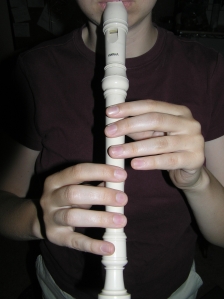So you want to join your local SCA dance band, but don’t play an instrument… or the instrument you do a play is a piano. You also don’t have a lot of money or time to spend on a new instrument and training. Really you want to get right into the thick of it as fast as possible. This is basically where I was 2 years ago. I’d played piano for 10 or so years, never played in a band (unless you count the digital piano band I was a part of during a summer workshop), and wanted to play along with Cynnabar’s dance band, Ritornello. I noticed one of the girls in the band was playing a plastic recorder and I remember that one was sitting in my parents basement. So the next time I visited them I dug it out and got to work.
What Kind of Recorder?
Plastic recorders are, in my opinion, the best entry-level instrument for renaissance dance music. A plastic Yamaha baroque soprano recorder costs less than $20 and many times you can even get it bundled with an instruction book. If want to play on a renaissance style recorder, the Susato brand plastic recorders may be a good choice for you. I’ve yet to try one myself, but I’ve heard good things about them. At $46 for a soprano, they’re about twice as expensive as the Yamaha recorders, but even then it’s still way under the price of a nice wooden one, which tend to start at around $400. Given the high quality of plastic recorders there’s no reason to rush into buying a wooden one until you know what you want.
Which Method Book Should I Buy?
If you already can read music, I don’t think it matters what method book you get. All you really need is an explanation of the fingering and some exercises gradual enough to get the fingering into your muscle memory. I used a book called Recorder Fun, which came bundled with my recorder back in 1991. True, the book was a bit on the juvenile side with songs like “Buzz, Buzz, Buzz, Buzz”, but it got the job done. I later got a more mature book called Basic Recorder Technique
, by Hugh Orr, which did have some useful advice on how to hold the recorder and how to generally articulate the notes, but aside from the first few pages I didn’t feel it had much more to offer. So, in the beginning I suggest that you just get a method book. Whatever method book you get doesn’t really matter.
How Do I Avoid Developing Bad Habits?
You may be wondering how you’d go about avoiding bad habits if you’re using any old method book. The truth is that recorder technique is something that every experience level works on. Both the beginner and the advanced player works on improving his/her posture, hand position, you name it. There’s no getting around relearning and refining how you handle and play your instrument. Sometimes you have to learn something wrong before you can learn it right. Your number one goal when you start learning is to get the basic fingering into your memory so you can start playing with others. After that you can clean up your playing.
Having said that, here are a couple general rules that you can apply right from the start that should help you avoid the common pitfalls.
Avoid Tension
If you notice your hands stiffening as you play faster runs relax them. Dexterity is executed through relaxation not stiffness. Similarly you want to hold your recorder in a relaxed manner. Just don’t collapse the wrists as this will also impede movement. If you’re having trouble positioning your right hand, a little trick to help with that is you can rotate the bottom part of the recorder to accommodate your pinky finger. This only works if it’s a 3 piece recorder, though.
Below is a picture of me holding the recorder in what I believe to be proper hand position. (It feels relaxed to me anyway.)
Avoid Staccato Articulation
It’s pretty easy to play the recorder when you separate each note by tonguing because you don’t have to develop good finger coordination to do it. The problem comes when you want to play music legato–connected–because that requires perfect coordination. So, I suggest using minimal tonguing to develop proper coordination right from the start. In fact it isn’t a bad idea to use no tonguing as an exercise to see if you can get the music to sound musical.
Explaining with words is one thing, but it’s much easier to understand if you can hear what I’m talking about. Here’s a recording of me first playing staccato (major tonguing) then no articulation legato (no tonguing) and then articulated legato (minor tonguing.)
Part 2 will be posted on Friday where I’ll discuss private lessons and what to do after you’ve finished the method book.

